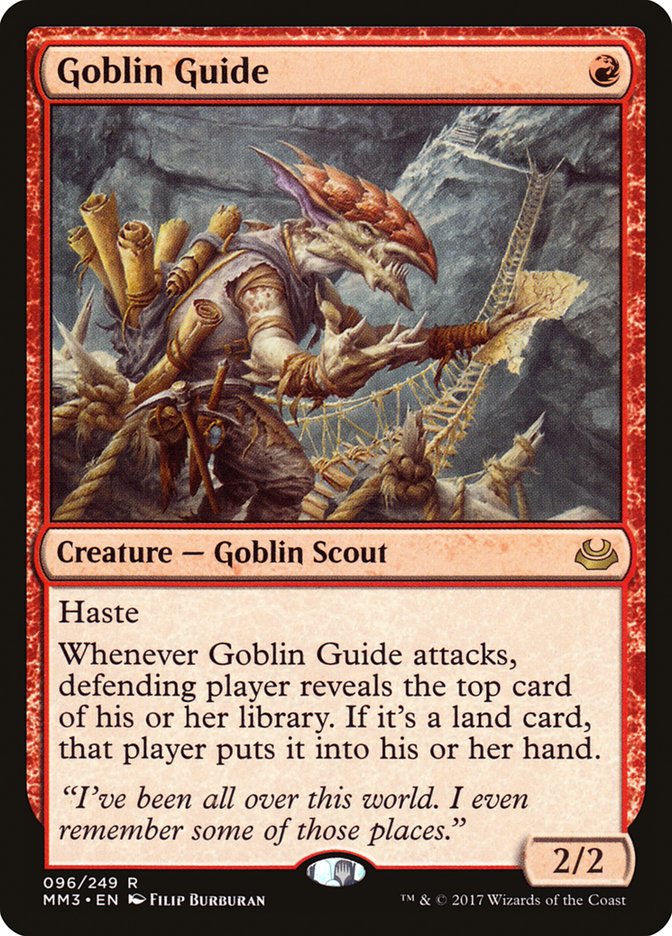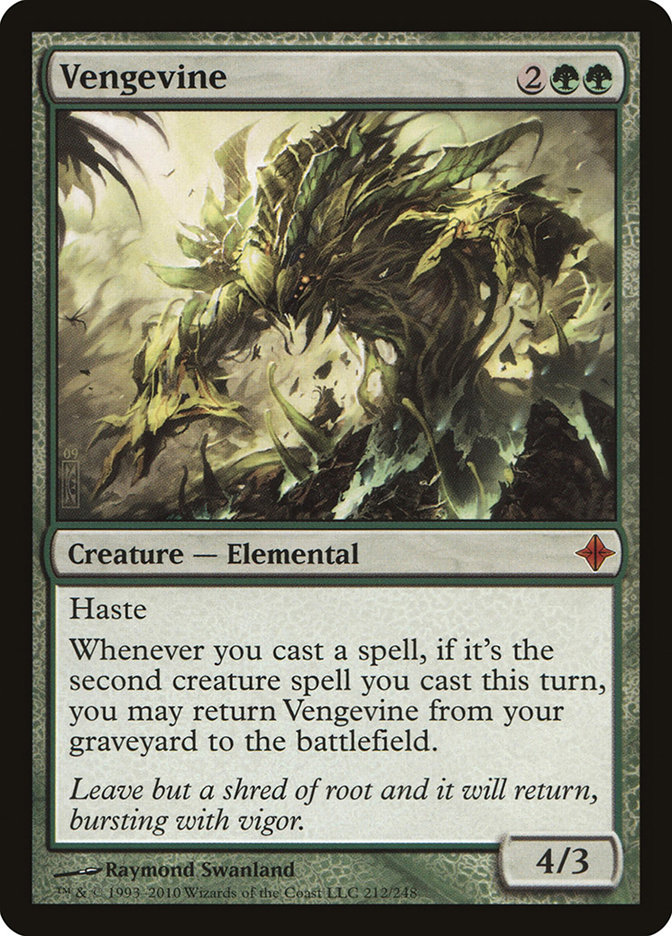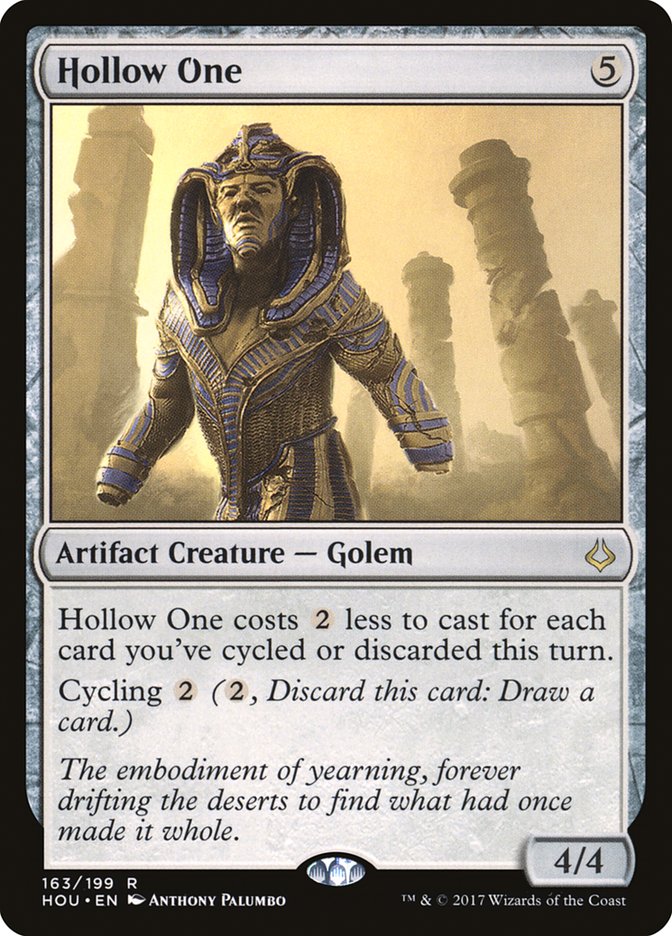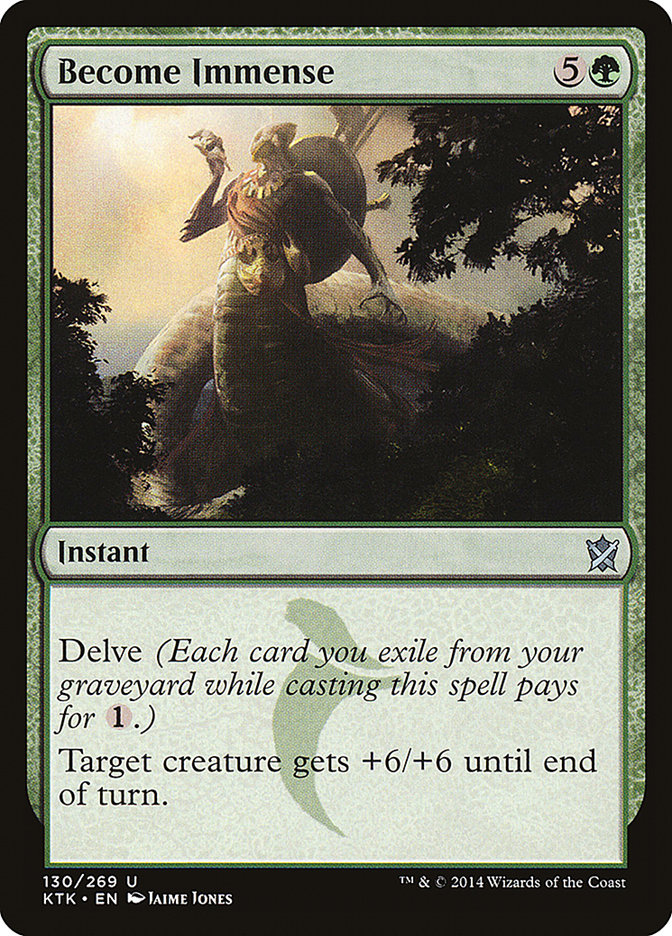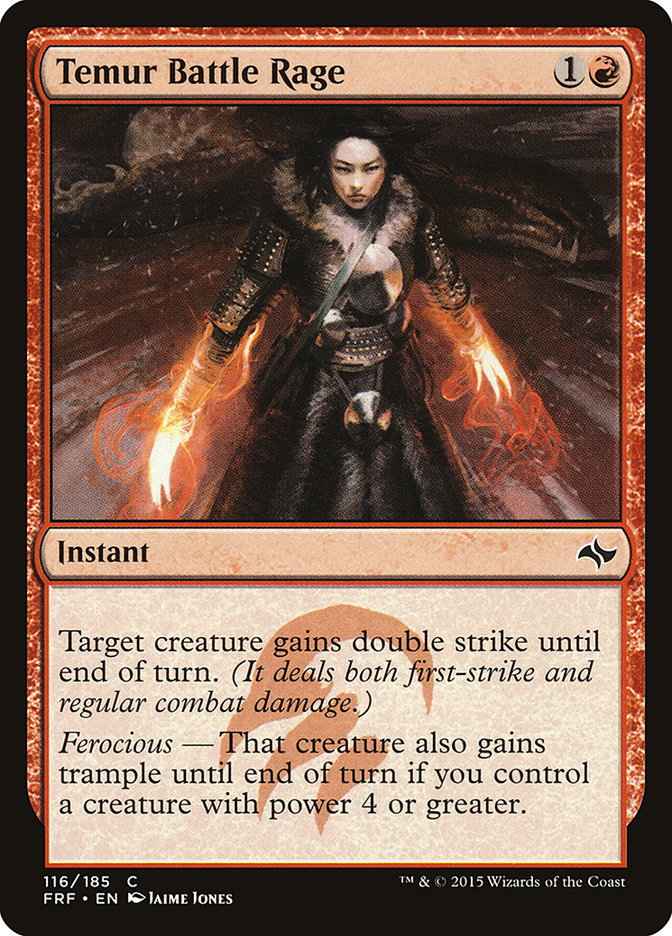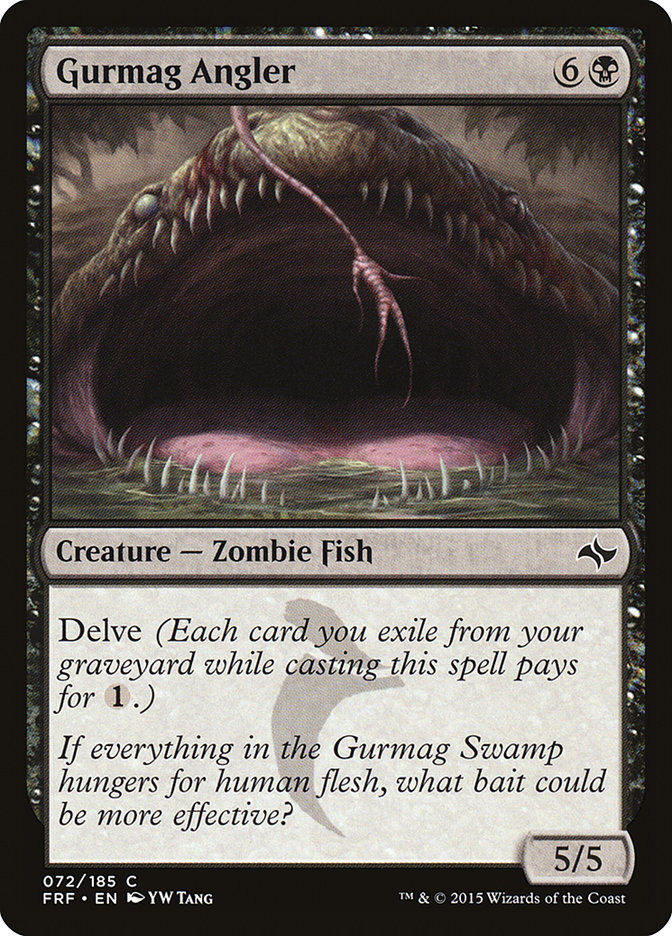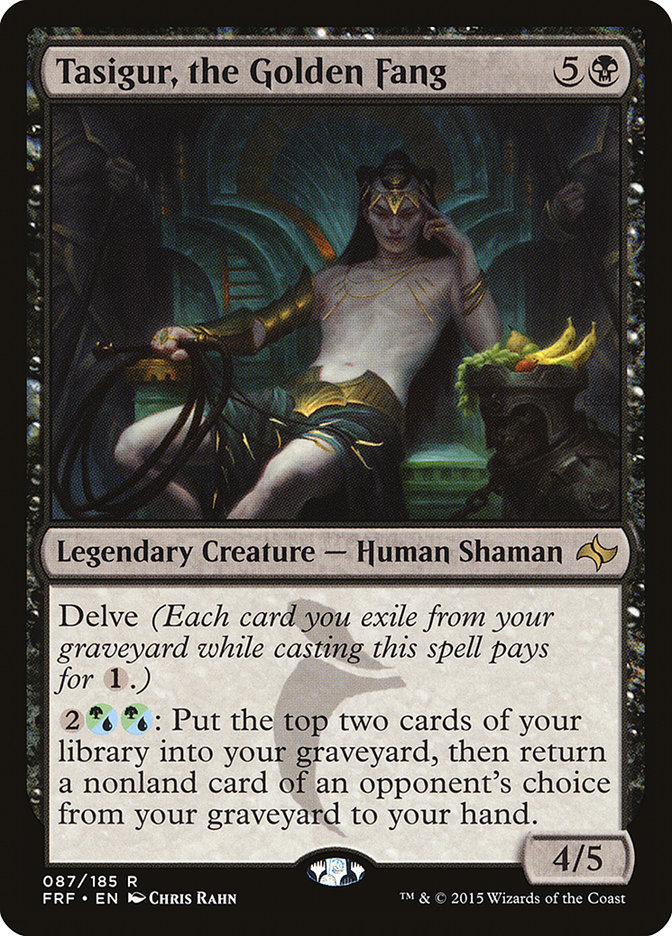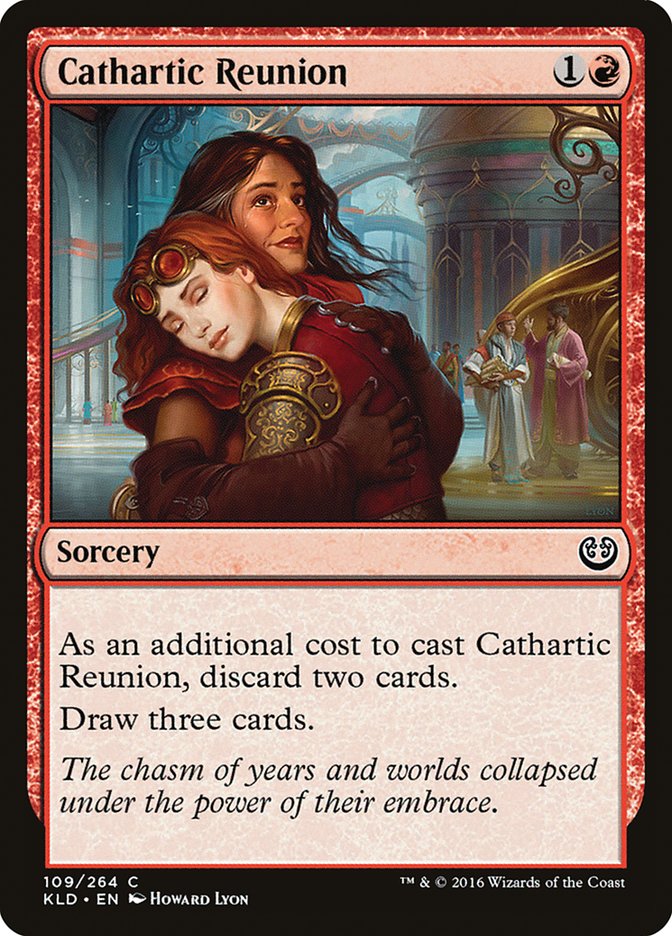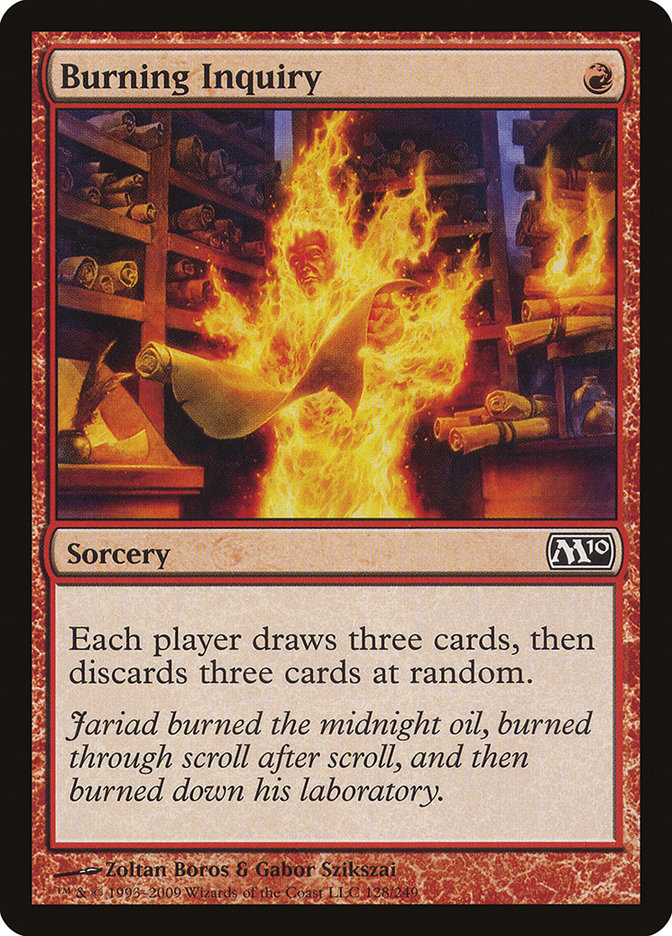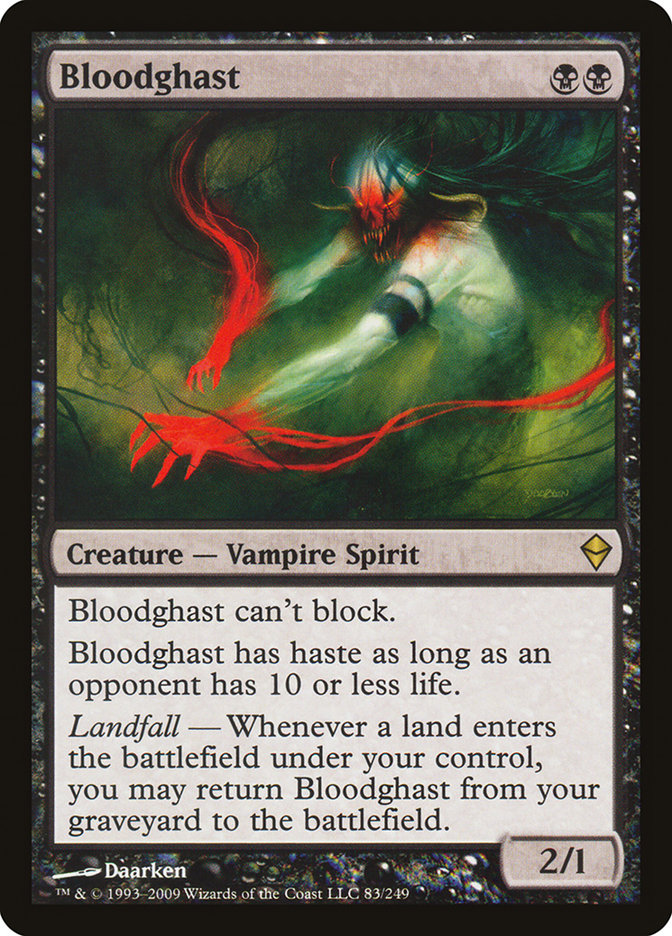This past weekend at SCG Richmond, I decided to play a Modern brew. After seeing Vengevine make somewhat of a comeback at SCG Syracuse, I couldn’t get it off my mind. Vengevine is one of the coolest cards ever made, and also one of my favorites.
Creatures (25)
- 4 Street Wraith
- 3 Goblin Guide
- 4 Vengevine
- 2 Hooting Mandrills
- 4 Monastery Swiftspear
- 4 Insolent Neonate
- 4 Hollow One
Lands (18)
Spells (17)

But it had some flaws. For starters, creatures like Goblin Guide and other one-drops aren’t very good after the first turn. That makes Vengevine somewhat awkward in an aggressive deck, since you want to be casting two creature spells in the same turn after you put one in the graveyard.
On top of that, it isn’t easy to make Hollow One a free creature. Most of the time, it is going to cost one mana, which means you will need three or four mana to go ballistic with it and Vengevine from the graveyard. That can make sequencing very difficult for the deck at times, since you need to make sure you can reduce the cost of Hollow One at the right time while also smoothing out your draws.
If you ever needed a sentence that shows Magic is a game of context, here it is: Lightning Bolt is also a pretty bad card at the moment. It doesn’t kill many creatures out of the two best decks in the format, Eldrazi Tron and Grixis Death’s Shadow. While Lightning Bolt has been a phenomenal card in the past, the evolution of Modern toward cheap, large creatures has put Lightning Bolt in a precarious position. It can be useful against a number of decks with cheap, small creatures, but I want my removal spell to kill just about everything (if I’m going to play a removal spell at all).
I did love the addition of Become Immense and Temur Battle Rage, but I don’t know how good that combo actually is at the moment. A lot of Modern decks feature a good amount of interaction, including Fatal Push, which can singlehandedly ruin your day. When the Modern format is more focused on ignoring the opponent, combos featuring Become Immense can be quite powerful. Unfortunately, with Grixis Death’s Shadow being one of the front-runners in Modern, the one-two punch of Become Immense and Temur Battle Rage just isn’t reliable enough.
So, with all these things in mind, I went forth constructing a Vengevine deck that could mitigate these drawbacks. I wanted creatures that were cheap, but also still solid after the first turn. That meant shying away from Goblin Guide and Monastery Swiftspear in favor of larger creatures. But how many good creatures are there in Modern that only cost one mana and are generally better on the second or third turn?
Creatures (24)
Planeswalkers (2)
Lands (18)
Spells (16)

For one, Death’s Shadow seemed to fit the bill perfectly. I saw a few people messing around with versions of Vengevine that played Death’s Shadow, and they immediately caught my attention. Not only do you get to play a powerful card as your one-drop creature, but you also have an alternate gameplan if your opponent decides to ruin your explosive draws with graveyard hate.
You also get to play Thoughtseize, which is arguably the best first-turn play in Modern. When your deck is already dealing itself a lot of damage with Street Wraith and lands, adding Thoughtseize and Death’s Shadow seemed like a no-brainer. But we still needed at least one or two more one-drop creatures. That’s where the Delve creatures fit in.
While Gurmag Angler is a little expensive, and is not entirely a one-drop creature, it does give you a powerful threat to cast when your engine isn’t running smoothly. Tasigur, the Golden Fang is a little smaller on stats, and you won’t be activating it much, but there is definitely something to be said about costing one less mana. After all, that one less mana could mean one less delve, which could be the perfect number to let Vengevine enter the battlefield from the graveyard.
The problem with playing more delve creatures is that you have to cut the Become Immense / Temur Battle Rage combo. As I said earlier, I don’t think it is all that good at the moment, so I’m more than happy to do just that. I’d much rather have a stable suite of threats that can dominate the battlefield on their own than have a gimmicky two-card combo that may or may not get you blown out by a single removal spell. And since Death’s Shadow can get very large without Become Immense, I don’t much see the need for the card at all. Temur Battle Rage, on the other hand, is a reasonable sideboard option to help you punch through board stalls from the opponent. We’ve seen this out of many different Death’s Shadow variants in the past, and I think it has enough utility to justify a slot now.
This was in my original list and just wasn’t good enough. In a deck full of removal, Liliana of the Veil is an insane card. If you want to attrition your opponent out, Liliana of the Veil is one of the best spells in Magic to help you do that. However, in this deck, you don’t interact with your opponent enough to make Liliana of the Veil a phenomenal card on her own, so I don’t think it should be in the deck. Ultimately, even with the discard synergy, it just wasn’t good enough.
My gut tells me that Fatal Push is worth playing, but I had quite a few spots where I wished it was any other card. There is a danger to playing too much interaction, but having Fatal Push in the right matchups, or situations, makes it feel like a necessary evil. While it can’t kill delve creatures or Reality Smasher, it does a fine job of helping contain cheap threats. And, after sideboarding, it gives you some really nice options for molding into a plain ol’ Death’s Shadow deck. When your opponent is going to have a lot of graveyard hate, making sure you have a solid plan that doesn’t rely on the graveyard is key. Fatal Push goes a long way in helping do just that.
Updates to Jund DeathVine
I dropped from the tournament at 4-3. One loss was to my own boneheaded mistake, while my other two losses came from a combination of poor draws and a misunderstanding of how my deck actually worked. Most of the time, you’re trying to nut-draw your opponent, but that isn’t how the deck plays out much of the time. This is especially true when you start adding interactive spells to your deck like Fatal Push and Thoughtseize. Instead of putting a ton of power onto the battlefield in the first two turns, you’re usually waiting until the third turn so you have access to more mana, which in turn makes your Vengevine plays more consistent.
I found myself going for the gusto on the second turn a bit too often, jamming my Cathartic Reunion and cycling Street Wraith looking for a second copy of Hollow One. That didn’t work out often enough for me to justify doing it, and I should have looked more toward interacting with my opponent or trying to use my mana in such a way that I was able to set up a reliable third turn. My greed for an explosive second turn often led to me losing games that I could have potentially won.
One thing is clear: both sides of the deck are powerful. The trick is integrating the two in such a way that they work seamlessly instead of contradicting one another. One thing was abundantly clear after just a few rounds of playing with the deck: Cathartic Reunion was far and away the worst card in the archetype. In fact, it was so bad that I am willing to cut it in favor of just about anything else. Yes, it can get you out of some bad hands, and could lead to some ridiculous turns, but it being countered often means losing on the spot. Plus, only discarding two cards means you need a Street Wraith to turn on Hollow One on the second turn.
The deck didn’t feature enough graveyard-related cards for Cathartic Reunion to shine. So, with that in mind, I think I’m going to try out Burning Inquiry next. While it doesn’t reliably put the cards into your graveyard that you would necessarily want (Vengevine) and might lead to some extraordinarily gross outcomes, it does singlehandedly reduce Hollow One to a zero-mana creature. It also gives you four cards in the graveyard for your delve creatures to boot. While it is a bit wacky, I think it could be just the right card for the deck, but I haven’t tried it for myself just yet.
My heart is telling me there’s really something here, but my head keeps screaming that this is just a worse version of Dredge. At the moment, I’m leaning toward my head, but I can’t help but feel like I’m just missing one or two key components. While I don’t necessarily know which direction to go just yet, I do have some ideas.
Bloodghast could make a notable addition to the squad. It gives you a few more cards that you’re happy to put into the graveyard, but it has obvious drawbacks when you’re trying to Delve or return Vengevine. It can’t block, which could play a major part in keeping you alive when you’re trying to get in lethal with Death’s Shadow. It also makes you more vulnerable to graveyard hate after sideboarding, which is something I’m currently trying to avoid.
Third on my list of things to try after Burning Inquiry and Bloodghast is a different color combination. I wracked my brain for hours on the night before SCG Richmond, looking for options. I thought about blue for the normal card selection and possibly Snapcaster Mage. Blue also gives you access to Stubborn Denial and Ceremonious Rejection, which are phenomenal interactive spells for non-interactive matchups. But since we don’t have a ton of interaction ourselves, Snapcaster Mage seemed pretty mediocre, yet I was still leaning toward splashing blue for sideboard options. After all, casting Vengevine isn’t exactly a priority, and casting Vengevine plus sideboarding Ancient Grudge were my only reasons for playing green in the first place.
As of right now, this is what I want to try next.
Creatures (28)
- 4 Street Wraith
- 4 Bloodghast
- 4 Death's Shadow
- 4 Vengevine
- 3 Gurmag Angler
- 1 Tasigur, the Golden Fang
- 4 Insolent Neonate
- 4 Hollow One
Lands (18)
Spells (14)

It seems a little all-over-the-place, but that’s kinda what I like about it. No one thing really hurts you too much. Graveyard hate like Rest in Peace and Leyline of the Void can be a kick in the teeth with the wrong type of draw, but what I’d really like to find is a sideboard plan that can help you mitigate those annoying hate cards. You don’t have enough instants and sorceries to make something like Young Pyromancer viable, and the color combinations featuring B/R don’t offer too many cheap, powerful threats that don’t rely on the graveyard in some capacity.
Here’s the short list for consideration:
The best one I’ve found as a standalone threat is Ammit Eternal. We haven’t seen much of what it can do yet, but I’m confident it will be solid against the type of decks that play Leyline of the Void or Rest in Peace. A few, like Bloodrage Brawler and Lotleth Troll (with some tweaks to the deck), could actually see maindeck play in the right scenario. With Lightning Bolt seeing a lot less play and discarding a card being a minor drawback, I think Bloodrage Brawler could easily make the cut. It might even be better than Cathartic Reunion or Burning Inquiry.
While Greenbelt Rampager is cute, it isn’t a serious consideration. I just thought it was sweet to have a one-drop creature that could be cast multiple times to trigger Vengevine. All the other creatures on the list besides Ammit Eternal don’t really tickle my fancy, but I wanted to give you the full rundown of the creatures running through my head. After all, when you’re working on a new deck, there is no such thing as a bad idea…just ideas that need to be crossed off the list. When building a sideboard, you need most or all of those cards to increase your win percentage against specific cards or matchups. Nothing besides Ammit Eternal seems like it would do that.
But that doesn’t mean these cards should be discounted completely. After all, I’ve seen Lotleth Troll in the maindeck of various Vengevine strategies in the last few years. Granted, it has been a long time since I’ve seen a Vengevine deck, I don’t think you should count cards like that out. Julian Grace-Martin caught my attention with his build of Vengevine featuring Hollow One. It will only be a matter of time before someone takes it a step further.
While I don’t know if this strategy will be as dominant as Grixis Death’s Shadow or Eldrazi Tron, I do think it has some serious legs. It got a lot of attention over the last week and change since SCG Syracuse, and I’m hoping a better deckbuilder than I am will be able to give it the love it deserves. Modern is full of so many options for a deck like this that it will only be a matter of time before someone truly breaks it.
That’s my read on the situation, anyway.
Modern Month Comes to a Close
With Grand Prix Washington DC in just a few weeks, I’m going to be putting a lot more effort into Standard. I’ve had a lot of fun writing about Modern, but Standard is actually fun right now, which is a breath of fresh air considering the last eight months. I’m very much looking forward to testing out the top five or six decks in the format, as well as some control and/or Temur brews.
Whether you want to play Zombies, Ramunap Red, Temur Energy, U/R Control, B/G Constrictor, or any other offering, I don’t think you can go wrong in Standard right now. Ramunap Red was at the top of the food chain during Pro Tour Hour of Devastation, but things have shifted since then. Zombies seems to have a favorable matchup against the archetype, but then what beats Zombies? And what beats that deck? It looks like we might have a rotating best deck from week to week, and I can’t wait to take a stab at it.


